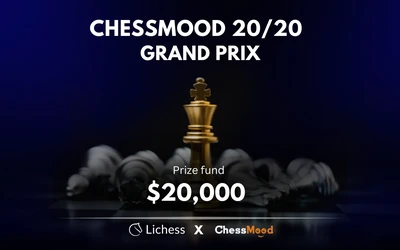
London Chess Classic: Round 6, "The Day of Sacrifices"
All the highlights from round 6 of the LCCRound 6 of the London Chess Classic was perhaps the most dramatic day of the tournament so far. On every single board, featuring eight of the world's top 10 players, sacrificed pieces, Greek gifts and poisoned pieces were played. Most impressively, Fabiano Caruana, the world number 2, played a long term queen sacrifice, a speculation which eventually paid off against his countryman Hikaru Nakamura in what was the game of the day, and possibly the game of the tournament.
On the other boards, Veselin Topalov's awful tournament continued as he registered his fifth loss against Wesley So who is building an unassailable lead in the final leg of the Grand Chess Tour. Levon Aronian started strongly against MVL, only to overextend himself and the Frenchman to capitalise on that weakness, receiving a win. Viswanathan Anand once again played 7. h3!? against Anish Giri's 12th Najdorf Sicilian in a row, a game which fizzled into a draw. Vladimir Kramnik and Michael Adams, by comparison, played a quieter game than the other 4 boards, in a solid positional battle which ended in a draw.
Fabiano Caruana (USA 2823) vs Hikaru Nakamura (USA 2779)
Caruana played an unusual, but not entirely novel Najdorf, which had received a large amount of analysis after Giri played it against MVL in 2015. The key position arose on 16...Ne5 17. Qxf4 Nexg4 18. Bxg4 e5 (forking knight and queen) 19. Qxf6! Bxf6 20. Nd5. Surprisingly, this position is still theory, with Stockfish giving an evaluation of +0.3 despite white being down a queen for two pieces of material. Simply, this is because of the positional dominance of white's position, the number of threats the black queen is exposed to, the limitations on black's king in a non-existent pawn structure, and the very few safe and useful squares for black's pieces.
Nakamura then played an inaccurate move with 21...Rb8!? a move aimed to prevent white from posting his bishop on f6, forcing the recapture of the black queen. Recommended by the top British grandmasters in the VIP room instead was the forced looking 21...Bxf5 , to prevent the possible continuation of 22. Nxf6+ Qxf6 23. Nxd6+ , a position Stockfish gives a clearly winning +3. Instead, Caruana played 22. Nxf6+ Qxf6 23. Rxd6 , not the strongest play possible, but still a dominant +0.7. Later, Caruana said he hadn't seen the strongest line's 25. Bf5, an elegant co-linear move preventing black's queen from picking up a bishop or escaping to a safer quadrant of the board.
White chose to castle on his exposed kingside to connect up his rooks, after which Caruana played the insightful 25. h5 with the aim of continuing to attack the queen with Bh4, giving only one safe square for white's queen on h8. After Nakamura prevented this line of play, his position regardless worsened after move 28...Qe7?? where black is simply lost after the relatively easy (for a GM of Caruana's calibre) 29. Nxf7+ after which all variations are simply winning for white. Instead, Caruana played 29. b5?? but after Nakamura played 29...Qe8?? it was still possible for Caruana to enter the winning line of 30. Nxf7+. If Bxf7, black's king is instantly exposed to 31. Rh6+ Kg7 32. Rg1+ giving the only legal move of 32...Bg6 and after **33. Rxg6+ Qxg6 34. Rxg6+**white has two active bishops, a passed pawn, a castled king and a rook for black's two rooks -- simply winning. A similar line is also played if black recaptures Nxf7+ with the queen, resulting in the same endgame position. Instead, black recaptured with the rook, surrendering the light-squared bishop immediately, and after 32. Rh6+ resigned.
Caruana claimed he hadn't prepared the position especially for Nakamura, but knowing the fellow American, predicted Nakamura would play a Najdorf in a "must-win" game. Caruana had researched the position after playing it through with his trainer, with his second (Uzbek GM Rustem Kasimdzhanov) studying the position more deeply for him. By move 19, Caruana described it as "one of the saddest positions [for black] I have ever seen...it's complete domination by knight and bishop." Going on to say, "it's easy to overlook, perhaps Nakamura over-relied on computer lines". Whilst he had spotted Nxf7+ as winning, he wanted to play more quietly and squeeze the life out of the position, but after recalculating after Qe8 saw it was winning faster than he had previously calculated. Nakamura was absent from interviewing.
https://lichess.org/study/QkqbvW0f/TNrazi8Y
Veselin Topalov (BUL 2760) vs Wesley So (USA 2794)
Topalov and So played an Italian game, with white rapidly playing Bg5 to pin the knight on f6. Black aggressively forced the bishop away, first with h6 and then g5. Surprisingly, So then castled kingside, despite his protective pawns being deeply advanced -- however, this was the exact replica of a game he had played against Topalov earlier in the Grand Chess Tour. However, unlike that other game, So played Nh7 to allow his queen more easily into the action and protect his advanced kingside pawns, before continuing with his intimidating looking assault, with a practically exposed king but his g pawn well protected on the 4th rank.
Topalov, who had countered So's flank attack with a push in the centre, then possibly made a blunder with 17. e5, which after 17...d5 possibly led to Topalov's second blunder by retreating his light squared bishop to e2, instead of d3 (with the possibility of putting pressure on the knight on h7, which could quickly mobilise into an attacking piece.) White attempted some counterplay on a position which had been quite balanced, but was now crushing for black, with 19. a5 (allowing Ra4 to enter the fray), but this plan was ultimately too slow and allowed black an unpreventable attack down either the open h-file or on the exposed f2 pawn.
Indeed, So's knight re-entered the fray, continuing the attack on f2, and it was clear that white's position was simply hopeless. White continued in desperation (perhaps because resigning by move 25 would perhaps be too embarrassing), but after 25...Bxf2+ 26. Kh2 Qe5 27. Kh3 Ne2, black can checkmate in two different ways, both of which cannot be prevented, and so Topalov resigned.

Topalov is having a disaster tournament, with a record of +0 -5 =1 overall, with this being his fourth loss in a row. This loss places him below Grischuk in the live ratings, putting him 21st in the world -- both 6 places below where he was at the start of this tournament, and also putting him well behind the lowest seed in this tournament, Michael Adams. A distraught Topalov graciously presented himself at the interview, but admitted he "didn't know what was happening" and recognised he collapsed on move 15, with both e5 and Be2 being mistakes. Topalov, clearly in pain, just simply said "my brain isn't working".
https://lichess.org/study/QkqbvW0f/TNrazi8Y
Maxime Vachier-Lagrave (FRA 2804) vs Levon Aronian (ARM 2785)
Aronian had prepared a Giuoco-Piano, who for much of the opening had the initiative over MVL, who refused to get involved with Aronian's preparation (such as by 16. Qxb7). MVL played more conservatively, and had a worse position than Aronian, who played the natural 18...e4 attacking white's queen and simultaneously expanding his centre.
Aronian must have miscalculated after 19. Nxe4 fxe4 20. Qxe4 and played Rf7 (to simultaneously protect the exposed knight on e7 and protect from white's queen getting a check on e6. Instead, the move 20...Qd7 should have been played, a far less natural looking move, as it looks like 21. Bxe7 will be the natural response. After 21...Rfe8, however, the bishop is effectively pinned to the queen, and black would have ended up in a favourable endgame.
Aronian continued battling however, having a rook's compensation for 2 pawns and a bishop. The bishop, however, was very active, and it was ultimately impossible to expose white's king enough to deliver a significant mating threat, with black having a partially exposed king of his own. By the endgame, white had picked up 5 pawns, fully compensating the dropped rook, with 4 of them passed on the queenside. Aronian chose to resign, rather than continue his suffering -- a disappointing result for what looked initially looked like a strong position for him.
MVL was surprised himself to have won the position, thinking that for much of the game "it looked completely drawn". MVL said he hopes to build on the result, and play better in the rest of the tournament -- saying that his win today was largely down to luck.
https://lichess.org/study/QkqbvW0f/B4E9wTt4
Vladimir Kramnik (RUS 2809) vs Michael Adams (ENG 2748)
Compared to all the other games played today, Kramnik and Adams chose more of a softly-softly approach rather than a wild and unbalanced game. In the words of GM Maurice Ashley, much of today didn't appear to be 21st century chess, but rather the wild attacking chess of the 19th and early 20th century. This game, however, was the complete opposite, with Kramnik playing a quiet Colle System.
Adams infiltrated with a queenside attack, taking a bishop for what looked like a rook with a sacrifice after the recapture 16. Qxb2, but the response 16...Ba3 skewered white's queen and rook, keeping equality and turning what initially looked like a sacrifice into a trade with delayed compensation.
Black then spotted another winning continuation which would allow him to take a lead in material, or (more reasonably) give him perpetual. Kramnik refused the winning line, and so the two players agreed to a draw just before move 40.
https://lichess.org/study/QkqbvW0f/fZ8thFiI
Viswanathan Anand (IND 2779) vs Anish Giri (NED 2771)
Anish Giri, responding to 1. e4 opted to played into the Najdorf for his 12th game in a row -- Giri, previously, has almost exclusively replied 1...e5, so Giri is clearly angling to play a more exciting style of chess. Anand responded much as how he did in his win against MVL (who also chose a Najdorf), with 6. h3 and following it up with a strong kingside attack. The players castled asymmetrically and the game was looking balanced, albeit aggressive when Anand played 17. Ndxb5, sacrificing a knight but for 3 pawns compensation.
Regardless, it wasn't a clear compensation, as Anand's king appeared to be exposed; his defenders were not in a fortress around the weak king, and there appeared to be multiple ways for black to attack white's position. Later, Stockfish evaluation shows that Giri had up to a -2 advantage in some of the positions throughout this game.
By move 25, Anand had spotted a thematic continuation which would give him a draw, and manoeuvred to make sure that Giri gave the draw offer by move 37 -- this is obviously an incredible achievement, with, in this tournament, only Kramnik's 16-move perfectly calculated draw against Nakamura in round 5 being more impressive.
Anand appeared to be relatively happy with the draw, and taunting a Giri who in round 5 had jokingly asked "when will Anand retire and give us a chance?" joked back by saying "when will Giri manage to actually win a game?"
https://lichess.org/study/QkqbvW0f/3knwwp0W
After round 6 of this very entertaining tournament so far, Wesley So is currently on a magnificent 4.5/6, but now Fabiano Caruana on 4/6 is posing a significant threat of removing him from first place. Kramnik is on 3.5/6, and then MVL, Aronian, Giri, Anand, Nakamura all on 3/6. Michael Adams is on a respectable 2.5/6, and it's difficult to not feel sorry for Topalov on an utterly miserable 0.5/6. Even as an amateur and club player, I'd be going utterly mental if I was 0.5/6 against my equals, so I cannot imagine what Topalov is going through.
There's still plenty to play for as we go into round 7, with Caruana, So and Kramnik all to play each other (if I recall correctly).
Theo Wait (Cynosure) is attending the London Chess Classic on behalf of lichess.org. He would like to thank Malcolm Pein, for arranging a press pass for lichess.org, and for organising such a brilliant competition. He would also like to thank his fellow staff members lukhas, FM lovlas, nojoke, bosspotato for proof reading, editing, and checking all aspects of this article. All photos by the talented Lennart Ootes.
More blog posts by Lichess

Women's World Chess Championship 2025 Preview: Ju Wenjun Profile
As the 2025 FIDE Women’s World Chess Championship is set to begin, Lichess profiles the defending ch…
Women's World Chess Championship 2025 Preview: Tan Zhongyi Profile
As the 2025 FIDE Women’s World Chess Championship is set to begin, Lichess profiles the challenger t…
Lichess Game of the Month: January '25
An entertaining material imbalance
